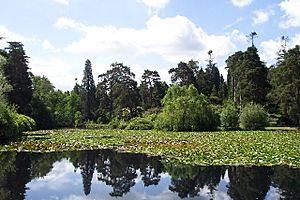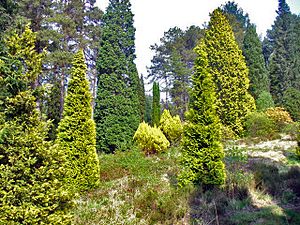Bedgebury National Pinetum facts for kids
Quick facts for kids Bedgebury National Pinetum |
|
|---|---|

Bedgebury National Pinetum, Kent
|
|
| Lua error in Module:Location_map at line 420: attempt to index field 'wikibase' (a nil value). | |
| Type | Conifer woodland, arboretum |
| Location | Bedgebury, Kent, UK |
| Area | 320 acres (130 ha) |
| Created | 1924 |
| Operated by | The Forestry Commission |
| Open | All year |
Bedgebury National Pinetum is a special forest in Bedgebury, Kent, in the United Kingdom. It's like a huge outdoor museum for trees, especially cone-bearing trees called Conifers. Together with the National Arboretum at Westonbirt, it forms the UK's National Arboreta.
This amazing place was started in 1925 to collect conifers. Today, it's known as the most complete collection of conifers in one spot anywhere in the world! There are over 10,000 trees growing across 320 acres (about 1.3 square kilometers). Many of these trees are rare, endangered, or have important stories. Bedgebury National Pinetum also works to protect trees and is home to about 56 species that are vulnerable or critically endangered.
Contents
History of Bedgebury Pinetum
Early Days and Name Origin
The name Bedgebury first appeared in an old Anglo-Saxon paper in the year 841. It comes from old words meaning "buy" and "to bend or turn," possibly about a stream.
The first known person to live at Bedgebury was John de Bedgebury, around the time of King Edward II. Later, in the 1400s, the Colepeper family owned the land. They made money from mining iron on the estate and created a beautiful park. Even Queen Elizabeth I visited in 1573!
New Owners and Developments
The main house you see today was built in 1688 for Sir James Hayes. Over the years, the estate changed hands many times. In 1789, John Cartier, who used to be the Governor of Bengal, bought it. He made improvements to the house and the tree plantings.
In the 1840s, Viscount William Beresford developed the area even more. He helped create the village of Kilndown. He also started the pinetum (the conifer collection) in the 1850s. His stepson, Alexander Beresford Hope, later built Lady Mildred's Drive. This allowed visitors to ride in carriages and enjoy the trees.
Becoming a National Treasure
By 1899, the estate was sold and the tree collection was not well cared for. In 1918, the Crown Estate bought the land.
In 1924, the Royal Botanic Gardens at Kew and the Forestry Commission teamed up. They decided to create The National Pinetum at Bedgebury. They chose this spot because the air pollution in London was making it hard to grow conifers there.
The first plants for the pinetum were grown at Kew Gardens in 1921. They were moved to Bedgebury in 1925 and 1926. These new trees joined the ones Viscount Beresford had already planted. A famous conifer expert named William Dallimore from Kew helped manage the collection.
In 1969, the Forestry Commission took over managing the pinetum completely. They made it even bigger in 1977 and added two new lakes. Sadly, in the Great Storm of 1987, almost a quarter of the trees were blown down.
The Amazing Tree Collection
The main goal of Bedgebury National Pinetum is to grow as many types of conifers as the weather allows. They try to plant them in groups, keeping trees from the same family or region together.
The pinetum has 10,000 trees and plants that grow in temperate zones (places with mild climates). This includes 7,000 trees! These trees act like living "gene banks." They hold important genetic information for future projects to bring back tree species.
There are 2,300 different kinds of conifers here. You can find the tallest tree in Kent, which is a Abies grandis. You can also see the three tallest Leyland Cypress trees in the UK! The plan is to have about 70% conifers and 30% other types of trees. They also keep 40% of the area open so you can enjoy the views and appreciate the trees.
Bedgebury National Pinetum is home to six special plant collections. These include collections of Yew trees, Junipers, Thujas, Lawson's Cypress, Leyland Cypress, and Cryptomeria japonica.
The collection also has 56 species that are officially listed as vulnerable or critically endangered. This means they are at risk of disappearing forever.
Conservation Efforts
Because Bedgebury has such a large and high-quality collection of conifers, it's a perfect place for conservation work. It takes part in the International Conifer Conservation Programme (ICCP). This program is run by the Royal Botanic Garden Edinburgh.
The ICCP works to protect conifers through special projects, research, and teaching people. The work done at Bedgebury helps save the different types of conifers, especially those from temperate forests.
The Bedgebury Conifer Conservation Project started in 2007. It uses empty forest areas to grow many endangered conifers, sometimes up to 500 of them! This creates an ex-situ genetic resource. This means they are growing trees outside of their natural habitat to protect their genes.
The first trees planted for this project were Chilean plum yew trees. Boy Scouts helped plant them in 2007 to celebrate their 100th anniversary. Future plantings will include trees from Europe, Asia, North America, and Australia.
The Bedgebury nursery was also the first place to successfully grow Vietnamese golden cypress and chichibu birch from seeds. This is a big step in helping these rare trees survive!
See also
 In Spanish: The National Pinetum Bedgebury para niños
In Spanish: The National Pinetum Bedgebury para niños



